Amphibious Architecture – “submerges ubiquitous computing into the water—that 90% of the Earth’s inhabitable volume that envelops New York City but remains under-explored and under-engaged.”
Toward the Sentient City, brought “architects and urban designers into a conversation that until now has been limited largely to technologists,†and created an extraordinary opportunity to investigate distributed architectures of participation of what we might call the “outernet.” This is a timely conversation as “web squared,” “smart things,” the “internet of things,” or the “outernet,” and their popular “ambassador” augmented reality are rapidly becoming everyone’s “business.” From “evil” marketers, to global corporations, environmentalists, artists and community activists - everyone, it seems, is interested in the possibilities of this new frontier.
It is a challenging task to respond to, Toward the Sentient City, an exhibition whose backdrop includes a series of conversations on Situated Technologies – published by the Architectural League, from a circle of people who have been thinking, writing, and speaking on networked urbanism for many years now, including: Adam Greenfield, Mark Shepard, Matthew Fuller, Usman Haque, Benjamin H. Bratton, Natalie JeremiJenko, Laura Forlano, Dharma Dailey, Philip Beesley, Omar Khan, Julian Bleeker, Nicolas Nova. And the exhibition itself has a very thoughtful group of respondents, see posts from: Dan Hill, Martijn de Waal, Enrique Ramirez, and Mimi Zeiger.
But one of Toward the Sentient City’s key accomplishments was to go beyond the rhetorical, and to put practical examples out into the world to organize a discussion on some of the ideas and possibilities of ubiquitous computing that have barely begun to emerge from academic research, and entrepreneurial blue skying. As curator, Mark Shepard, explained:
“The aim is to provide concrete examples in the present around which to organize a discussion about just what kind of future we might want. Whether they’re prototypes or not, these commissions are concrete examples. They’re not abstract ideas. And we can go stand next to each other and look at and interact with something which is out there in the world behaving in the way it behaves, performing as it does, and we can then begin to have a discussion about it that is less dependent upon powers of rhetoric. So it’s not about me persuading you about an idea but it’s about us evaluating something that’s living and existing in this world. And that was really the intention of the show.â€
The commissioned works - Amphibious Architecture, Breakout!, Natural Fuse, Too Smart City, and TrashTrack, that were the hub of Toward the Sentient City’s events, themes and texts, provided a unique glimpse at some of the possible dystopian and utopian futures of a “smart” city. But, most importantly, all the works questioned what might be new architectures of participation for a sentient city.
New Architectures of Participation: Hybrid Social Networks with Human and Non-human Participants .
Of the five works, Amphibious Architecture and Natural Fuse were particularly fascinating to me because they explored the possibilities of sensor networks to create new forms of distributed participation in networked ecosystems that connected the experience/trajectories of human and non human actors – fish, plants, and people.
Both Amphibious Architecture, and “Natural Fuse” – from Usman Haque and Haque Design + Research, gave exhibition attendees the chance to experience at a personal level our relationships with our non-human neighbors.
Amphibious Architecture from the The Living Architecture Lab at Columbia University Graduate School of Architecture, Planning and Preservation (Directors David Benjamin and Soo-in Yang) and Natalie Jeremijenko, Environmental Health Clinic at New York University, used a sensor array to “pierce the reflective surface of the water” that separates us from the underwater ecosystem below. The sensor arrays just below the surface of the East River and floating light array (see picture on left opening this post) create a new interface between people and fish whose movements and water quality are transmitted in light.
One could also SMS the fish and the single beaver that lives in the rivers surrounding NYC to find the conditions they were experiencing. But turning the city’s “back stories,” like the movements of “Yo beaver,” and the oxygen levels and water quality of the rivers into “fore stories,” is only one of the many ways Natalie JeremiJenko explores how we can engender the empathy necessary for humans and non humans to live in harmony and mutual benefit.
Toward the Sentient City also held workshops/presentations in conjunction with Conflux 2009. After her Conflux presentation, Natalie Jeremijenko of Amphibious Architecture (which is also a collaborative project between xClinic, The Living, “and other intelligent creatures on the East River”)Â invited participants to enjoy a lunch of cross-species foods at the East River site.Â
The cross-species lunch takes an existing interaction pattern through which people and fish are already communicating, i.e., people going to the river – the waterfront, and feeding the fish Wonder Bread (which is bad for humans and fish); and transforms this desire to feed the fish into something which actually can remove the mercury content from the fish and our bodies by removing it from the food chain, so a previously inharmonious connection between people and fish, is redirected into a productive interaction benefitting both species. As it turns out, food that is good for Fish (see pictures above), and removes mercury from their bodies can also be nutritious and tasty for humans.
Natural Fuse, from team members, Usman Haque, creative director, Nitipak ‘Dot’ Samsen, designer, Ai Hasegawa, designer, Cesar Harada, designer, Barbara Jasinowicz, producer, used sensors to link humans and plants in network where we are accountable for how our behavior effects others in your ecosystem.
If you brought an ordinary plant to the exhibition, you could take home an electronically assisted plant and become part of a social network of humans and plants. This network of humans and electronically assisted plants is also a carbon sink and if more energy is consumed than the total number of plants in the social network can offset, plants begin to die giving immediate feedback and consequences to being greedy about energy consumption. For more about joining the Natural Fuse network see here.
We are in the pre-dawn of sensor networks like those Natural Fuse and Amphibious Architecture created – social networks that link human and non human participants in entirely new ways are largely an uncharted territory. (Note: The upcoming Situated Technologies Pamphlet 6 – “Micro Public Places,” Marc Bohlen and Hans Frei, indicates it will continue the journey with an investigation of “transparent and distributed participation.”)
Where Does the Social Negotiation of Technology Happen?
Frequent questions that came up at the presentations given by the teams that produced the commissioned works were: Does this idea scale?  Does it close the loop in that you get answers to the questions asked? How does the conversation gain agency? And where does the social negotiation of technology happen? (These last two questions were asked by Mike Kuniavsky at Mark Shepard’s presentation at Conflux: “Sentient City Survival Kit.†– see picture above) I think it is fair to say that these questions for the most part remain unanswered. But Toward the Sentient city was alive with ideas and practical examples about ways we can explore these questions more deeply.
Usman Haque in response to the question, “Does this experiment scale?,” replied:
“it would, but at an individual level because it has to remain at the individual level because it is about the individual in relationship to the wider social context as opposed to building a forest to offset a city it is about each individual making choices of their own about what they do and having some kind of knowledge about the effect they are having on other people because most of the time we are quite complacent – we are able to do whatever we want because we are not necessarily aware how our intrusions effect both human and non-human neighbors….’
So how does this close the loop? Usman explains that one of the key aspects for him is that if you do take home a plant you become part of a system in which you are no longer anonymous and if a plant is threatened (plants get three lives) you have the opportunity to email the person in the system who has threatened your plant. Usman noted that one of the interesting things that happened in the context of the exhibition, where there was a single unit, was that 90% of the time people switched it on to selfish mode – presumably because they were anonymous. Another aspect of Natural Fuse that raises interesting questions is that as more people decide to join the network the risk of a plant being harmed by any particular individual’s selfishness lessens. As Martijn de Waal, in his response that unpacks some of the deeper philosophical, epistemological, and ethical questions that Natural Fuse addresses, observes:
“The concept of a commons thus assumes cooperation and mutual accommodation. Could Sentient Technology play a role in the allocation of limited resources between citizens? Could it lead to the emergence of some sort of peer-to-peer governance model, that could prevent overusage of scarce resources?”
New Aesthetics of Distributed Participation
The works of, “Toward the Sentient City” point to possibilities for a new aesthetics of distributed participation in which users and system are no longer separated but instead “develop joint forms of observing and knowing that neither [...] is capable on its own.†(quote from upcoming, Situated Technologies Pamphlets 6: Micro Public Places, Marc Bohlen and Hans Frei). Natural Fuse and Amphibious Architecture examine the new transactional realities of the Sentient City.
But there are many questions left unanswered. We know a lot about the power of generativity from the internet (see Zittrain)- the ur “architecture of participation.” As Zittrain points out, the “generativity” of the internet is “the engine that has catapaulted the internet from backwater to ubiquity.” Tim O’Reilly coined the phrase, “architecture of participation,” to “describe the nature of systems that are designed for user contribution,” such that “participants extend the reach/increase the value of the system.” But as Tim O’Reilly put it in his recent talk, “State of the Internet Operating System:”
“Web 2.0 is about finding meaning in user-generated data, and turning that meaning into real-time user facing services. “Web Squared” takes that same concept to real-time sensor data.”
We know little yet about what constitutes generativity for the “outernet,” particularly for the kind of hybrid social networks that Natural Fuse and Amphibious Architecture present. Social Networks that connect people and place, humans and non humans, challenge dichotomies of man and nature, and machine and user in new and unexpected ways.
At the moment, the internet is going through a metamorphosis with the emergence of real time technologies like XMPP, PubHubSubBub and Google Wave and the coming of age of mobile computing.  While these shifts were not investigated specifically in any of the commissioned works I think all the works begged the question, What is a common platform for social interaction in the “outernet,” or sentient city? I was not entirely satisfied, from this point of view, with a web interface for Natural Fuse or SMS as a mobile interface for Amphibious Architecture.
David P. Reed points to the relationship between social mobility what he describes as the 3rd cloud and the need for a common platform (see David Reed – Social Mobility and the 3rd Cloud. Hat tip to @srenan for pointing me to David’s presentation).
Slides above are from David P. Reed’s presentation, Social Mobility and the 3rd Cloud
What is an architecture of participation for mobile, social interaction? This is something I am very interested in.
Recently I began a project with a small group of augmented reality developers and enthusiasts to use Google Wave Federation Protocol as a transport system for open distributed, social augmented experiences (lots more to come on this soon – you can see the back story in my posts here and here). Wave has introduced an open federated architecture of participation that combines asynchronous & synchronous data, bringing together the advantages of real-time communication with the persistent hosting of collaborative data (like wikis).
Augmented Reality puts who you are, where you are, and what you are doing center stage, and is an interface for “communications embedded in context” and “enabled by identity” – two key qualities of what David P. Reed calls the 3rd cloud. An open, distributed framework for augmented reality could create an interconnected sense of AR, one that fuses augmentation, data overlays, and varied media with location/time/place and crucially, social networking. Such an interface would open up many possibilities for the new transactional realities that could integrate real-time cloud based data with a human perspective and social networking. I am using the term, transactional realities to suggest an extension into social augmented experiences of what, Di-Ann Eisnor, Platial, describes as, “transactional cartography” – “the movement from map providing entertainment/information to map as enabling action” (see Human as Sensors).
We have only just got a glimpse of how real time technologies and “communications embedded in context” will transform social interaction and our cities. This post on Writing as Real-Time Performance that looks at the Google Wave playback feature is a brilliant example of how real time technology turns familiar practices like writing inside out, and catapaults us into new time trajectories. And, if you haven’t already seen Matt Jones of BERG’s, brilliant look at, “All the time in the world” - from the “soft time” and “squishy time” of cell phone culture, to their anticedents in real-time computing, go now! Also see Dan Hill’s work on “time based notation,” and Tom Carden’s work for mysociety.org
Transactional Realities Between the “Asynchronous City” and the “Synchronous Internet of Things”
Out of Toward the Sentient City’s five commissioned works, only Trash Track focused on the “synchronized Internet of Things.†Trash Track asks what can we learn from the aggregated data streams of “smart†trash about the infamous path of trash from cities of privilege to rivers of want, rather than exploring the the particular transactional realities of a social network that linked people with their trash
The goals of Trash Track were, Assaf Biderman explained during his presentation:
“to learn about the removal chain, to see if knowing more could promote behavioral change, and investigate if smart tagging could one day lead to 100% recycling.â€
The team from SENSEable City Laboratory, MIT included – Carlo Ratti: Director, Assaf Biderman: Associate Director, Rex Britter: Advisor, Stephen Miles: Advisor, Kristian Kloeckl Project Leader, Musstanser Tinauli, E Roon Kang, Alan Anderson, Avid Boustani, Natalia Duque Ciceri, Lorenzo Davolli, Samantha Earl, Lewis Girod, Sarabjit Kaur, Armin Linke, Eugenio Morello, Sarah Neilson, Giovanni de Niederhausern, Jill Passano, Renato Rinaldi, Francisca Rojas, Louis Sirota, Malima Wolf.
However, Assaf, in his presentation, presented another project from SENSEable City Laboratory in partnership with the City of Copenhagen, The Copenhagen Wheel. This project seems to work brilliantly at the intersection of the “asynchronous city” (Bleeker and Nova) and the “synchronized internet of things” The “smart” wheel – a low cost, open source, human electric hybrid is:
“an electric bicycle wheel that can be easily retrofitted into any regular bicycle and location and environmental sensors which are powered by the bike wheel and in turn provide data for a variety of applications.”
This project, that aims to promote urban sustainability through smart biking, opens up many possibilities for a bottom up architecture of participation for the sentient city (see video here).
Mark Shepard describes something he calls “propagative urbanism:”
“a way of thinking about shaping the experience of urban space in terms of a bottom-up, participatory approach to the evolution of cities.”
And, in the most recent pamphlet in the Situated Technologies pamphlets series, #5 “Asynchonicity Design Fictions for Asynchronous Urban Computing,†Julian Bleeker and Nicolas Nova invert an emphasis in the so-called “real-time database enabled city†with its synchronized Internet of Things…. and speculate on the existence of an “asynchronous city.â€Â They “forecast situated technologies based on weak signals that show the importance of time on human perspectives.â€Â They ask:
“why, besides ‘operational efficiency,’ would we want a ubiquitously computed environment? What are the measures of ‘better’ that we want to count as meaningful?”
They explain:
..we are trying to think through what “urbanwares might be – urban operating systems – if they were less about synchronization, top-down construction and connected channels of information and databases and so forth, and more about asynchronized, decentralized things. Software, data, time out of alignment, incongruities, tiles and imbrications of the geographic, spatial parameters into a delicious kind of lively peasant’s stew.”
One takeaway, perhaps, from Toward the Sentient City is that it’s at the intersection of the “asynchronous cityâ€Â and the “real-time database enabled city†where many new transactional realities of the sentient city will arise.

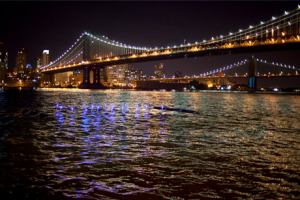
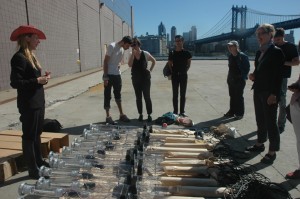
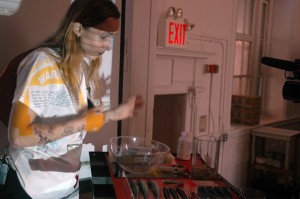
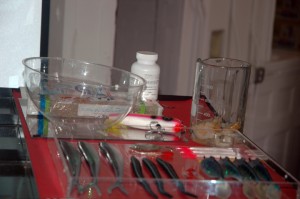
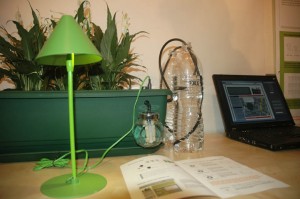
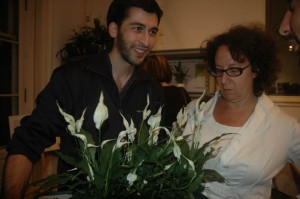
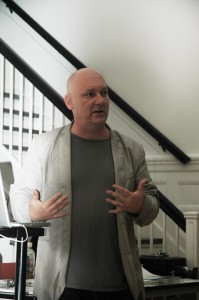
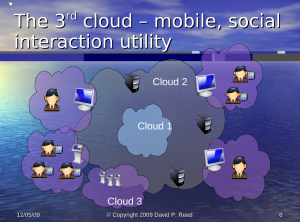
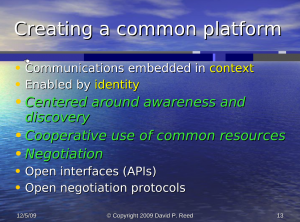
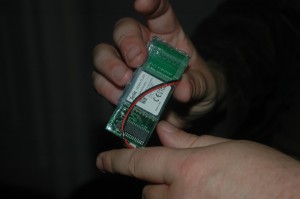
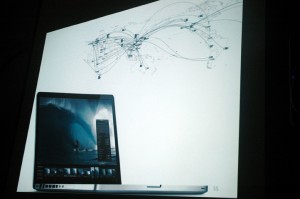
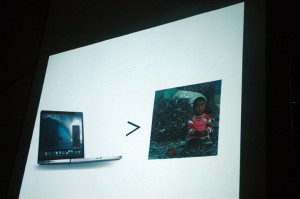
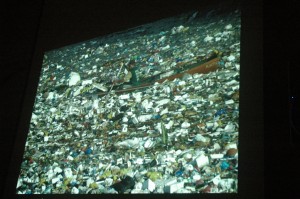
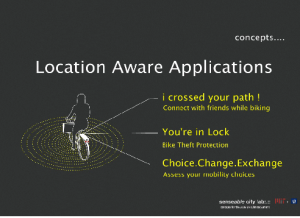
March 31st, 2011 at 12:58 pm
You wrote:
“This network of humans and electronically assisted plants is also a carbon sink and if more energy is consumed than the total number of plants in the social network can offset, plants begin to die giving immediate feedback and consequences to being greedy about energy consumption.”
What a wonderful idea, a natural feedback mechanism that lets us know when we cross the line with our energy consumption. I have thought that it would be a good idea to have some kind of notification device in ones abode to let them know how much energy is being used and give feedback about the effect their level of consumption has on the planet. But living thing that would require nurturing, via lower energy consumption, would be a much more experiential and powerful meter.
Dani
April 9th, 2011 at 1:48 am
@ Dani said, “What a wonderful idea, a natural feedback mechanism that lets us know when we cross the line with our energy consumption. I have thought that it would be a good idea to have some kind of notification device in ones abode to let them know how much energy is being used and give feedback about the effect their level of consumption has on the planet. But living thing that would require nurturing, via lower energy consumption, would be a much more experiential and powerful meter.”
It’s amazing how far technology has progressed, yet we really don’t…if you think about it..really do not have a way to accurately monitor how much we consume in our homes. If there was a way to do this, it would be wonderful if we could monitor the energy use on an on-demand basis. Thank you.